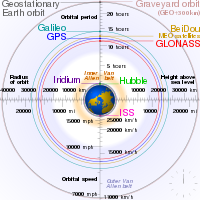
Photo from wikipedia
Abstract Satellites in low Earth orbit (LEO) are subject to several environmental factors, atomic oxygen (AO) having the greatest effect on space materials, especially polymers. Recently, the possibility of utilizing… Click to show full abstract
Abstract Satellites in low Earth orbit (LEO) are subject to several environmental factors, atomic oxygen (AO) having the greatest effect on space materials, especially polymers. Recently, the possibility of utilizing orbits at an altitude lower than 300 km (super LEO or S-LEO) has been explored, but one complication in using these orbits is that AO fluence is expected to far exceed that in an ordinary LEO. The effect of S-LEO AO on materials used in space is not well understood. To investigate the influence of S-LEO AO on space materials, we developed the Material Degradation Monitor (MDM), which is installed on a JAXA spacecraft, the Super Low Altitude Test Satellite (SLATS, also known as TSUBAME). The SLATS is the first S-LEO satellite to operate at an altitude under 200 km and the MDM is the first near real-time experiment to examine the effects of AO on materials in this orbit. The aim of the MDM is to clarify degradation behaviors of the space materials according to AO fluence. We developed the instruments needed to detect AO fluence and the changes it causes to samples of various materials in S-LEO. The MDM performed as expected until the end of the SLATS operation. Some changes in materials were found from the images taken from front and back LEDs. Although there was no breakage by AO, optical properties changed that are assumed to be due to material erosion by AO.
Journal Title: Acta Astronautica
Year Published: 2021
Link to full text (if available)
Share on Social Media: Sign Up to like & get
recommendations!